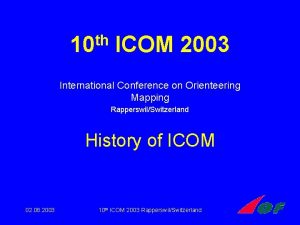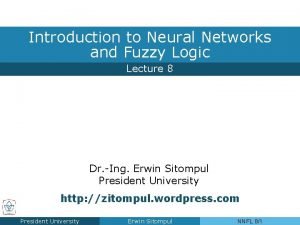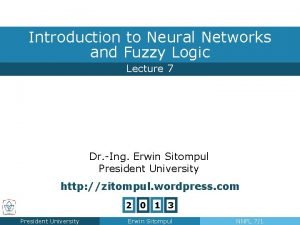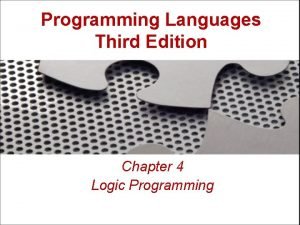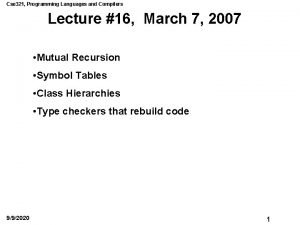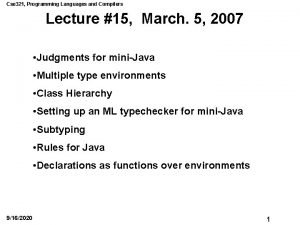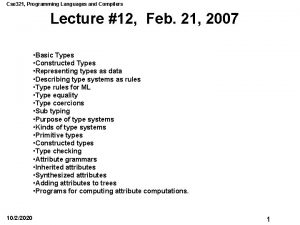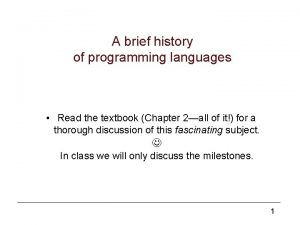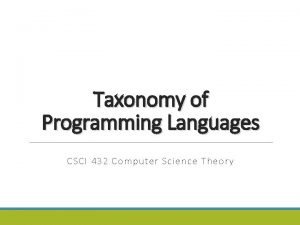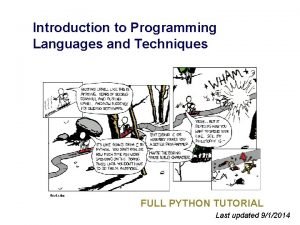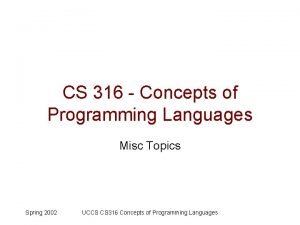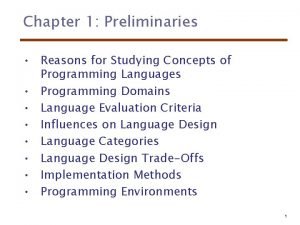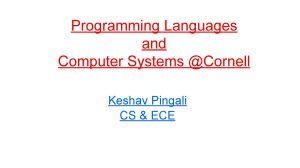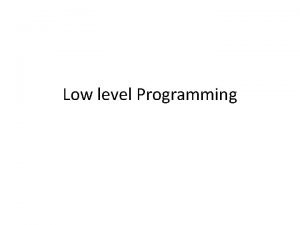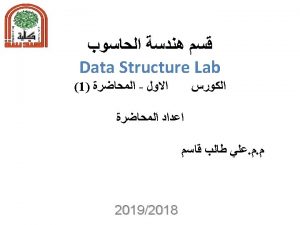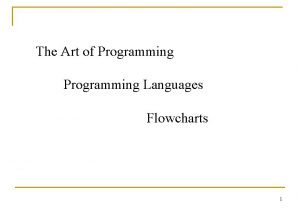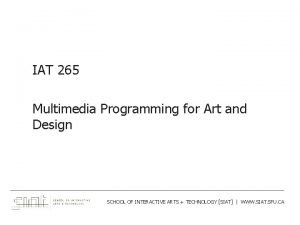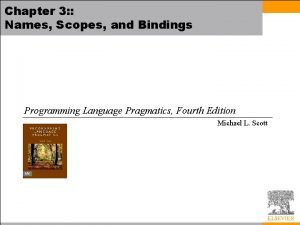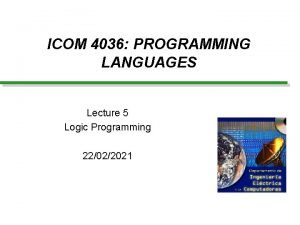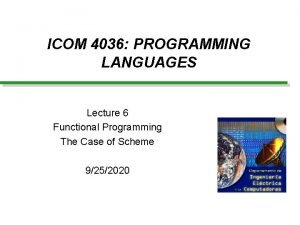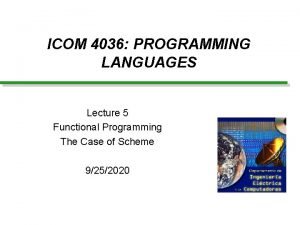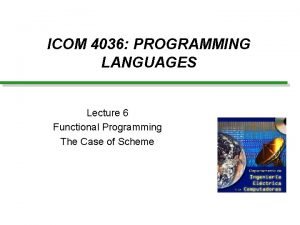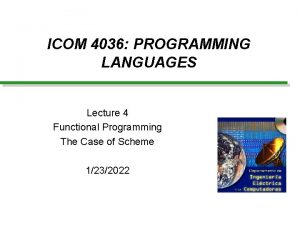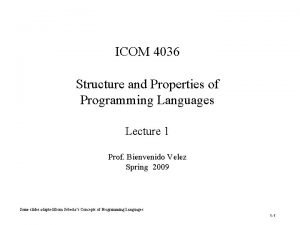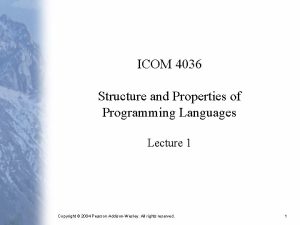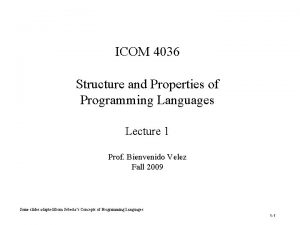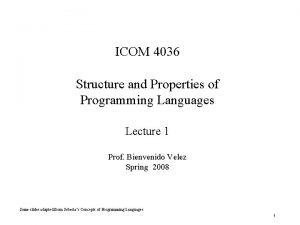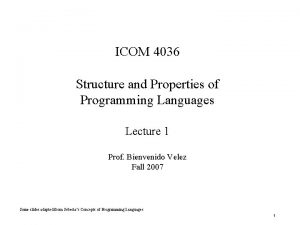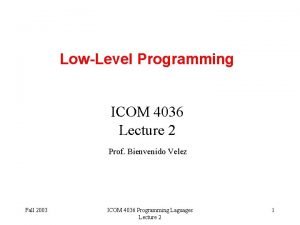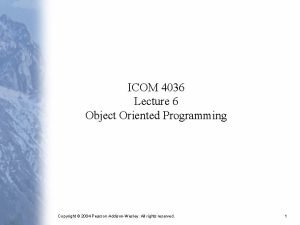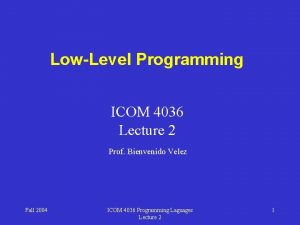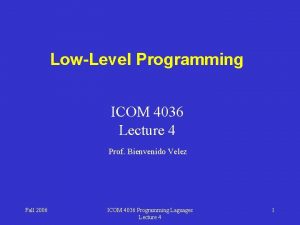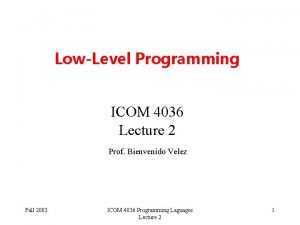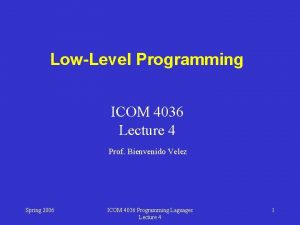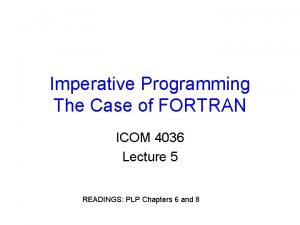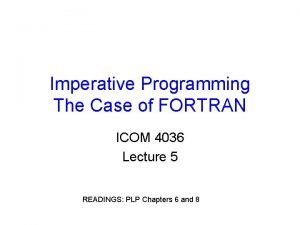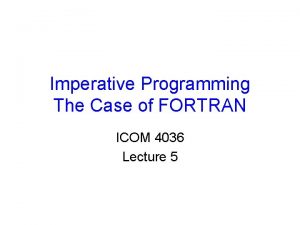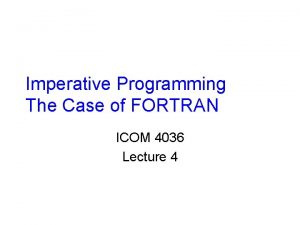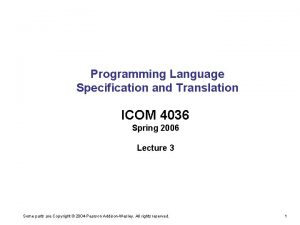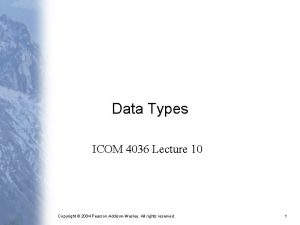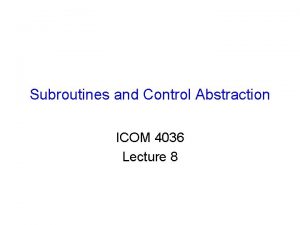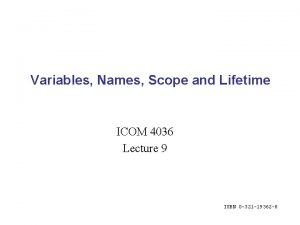ICOM 4036 PROGRAMMING LANGUAGES Lecture 5 Logic Programming






![Prolog Notation ® A rule: X [p(X) (q(X) r(X))] is written as p(X) q(X), Prolog Notation ® A rule: X [p(X) (q(X) r(X))] is written as p(X) q(X),](https://slidetodoc.com/presentation_image_h2/071cb8635e9d9076d2574e92be7d46bb/image-7.jpg)






![Lists in Prolog mylength( [ ], 0). mylength( [X | Y], N): – mylength(Y, Lists in Prolog mylength( [ ], 0). mylength( [X | Y], N): – mylength(Y,](https://slidetodoc.com/presentation_image_h2/071cb8635e9d9076d2574e92be7d46bb/image-14.jpg)
![List Membership mymember( X , [X | Y] ). mymember( X , [W | List Membership mymember( X , [X | Y] ). mymember( X , [W |](https://slidetodoc.com/presentation_image_h2/071cb8635e9d9076d2574e92be7d46bb/image-15.jpg)


![Appending Lists ? - append([1, 2, 3, 4, 5], [a, b, c, d], Z). Appending Lists ? - append([1, 2, 3, 4, 5], [a, b, c, d], Z).](https://slidetodoc.com/presentation_image_h2/071cb8635e9d9076d2574e92be7d46bb/image-18.jpg)











![Binary Search Trees ? - [btree]. ? isbtree(node(6, node(9, empty), empty)). no ? isbtree(node(9, Binary Search Trees ? - [btree]. ? isbtree(node(6, node(9, empty), empty)). no ? isbtree(node(9,](https://slidetodoc.com/presentation_image_h2/071cb8635e9d9076d2574e92be7d46bb/image-30.jpg)


![Sublists (Goal Order) myappend([], Y, Y). myappend([H|X], Y, [H|Z]) : myappend(X, Y, Z). myprefix(X, Sublists (Goal Order) myappend([], Y, Y). myappend([H|X], Y, [H|Z]) : myappend(X, Y, Z). myprefix(X,](https://slidetodoc.com/presentation_image_h2/071cb8635e9d9076d2574e92be7d46bb/image-33.jpg)
![Sublists ? - [sublist]. ? - sublist 1([e], [a, b, c]). no ? - Sublists ? - [sublist]. ? - sublist 1([e], [a, b, c]). no ? -](https://slidetodoc.com/presentation_image_h2/071cb8635e9d9076d2574e92be7d46bb/image-34.jpg)
![Version 1 So what’s happening? If we ask the question: sublist 1([e], [a, b, Version 1 So what’s happening? If we ask the question: sublist 1([e], [a, b,](https://slidetodoc.com/presentation_image_h2/071cb8635e9d9076d2574e92be7d46bb/image-35.jpg)
![Version 2 On the other hand, if we ask the question: sublist 2([e], [a, Version 2 On the other hand, if we ask the question: sublist 2([e], [a,](https://slidetodoc.com/presentation_image_h2/071cb8635e9d9076d2574e92be7d46bb/image-36.jpg)









![Insertion Sort isort([ ], [ ]). isort([X|Un. Sorted], All. Sorted) : isort(Un. Sorted, Sorted), Insertion Sort isort([ ], [ ]). isort([X|Un. Sorted], All. Sorted) : isort(Un. Sorted, Sorted),](https://slidetodoc.com/presentation_image_h2/071cb8635e9d9076d2574e92be7d46bb/image-46.jpg)
![Tail Recursion Recursive reverse([ ], [ ]). reverse([XL], Rev) : - reverse(L, RL), append(RL, Tail Recursion Recursive reverse([ ], [ ]). reverse([XL], Rev) : - reverse(L, RL), append(RL,](https://slidetodoc.com/presentation_image_h2/071cb8635e9d9076d2574e92be7d46bb/image-47.jpg)

- Slides: 48

ICOM 4036: PROGRAMMING LANGUAGES Lecture 5 Logic Programming 12/13/2021

What is Prolog ® Prolog is a ‘typeless’ language with a very simple syntax. ® Prolog is declarative: you describe the relationship between input and output, not how to construct the output from the input (“specify what you want, not how to compute it”) ® Prolog uses a subset of first-order logic

First-Order Logic ® Simplest form of logical statement is an atomic formula. An assertion about objects. Examples: is-man(tom) is-woman(mary) married-to(tom, mary) mother-of(mary, john)

First Order Logic ®More complex formulas can be built up using logical connectives: ® Men and Women are humans w X [is-men(X) v is-woman(x) is-human(x)] ® Somebody is married to Tom w X married-to(tom, X) ® Some woman is married to Tom w X [married-to(tom, X) is-woman(X)] ® John has a mother w X mother-of(X, john) ® Two offspring of the same mother are siblings w X Y Z [mother-of(Z, X) mother-of(Z, Y) siblings(X, Y)] is the Existential quantifier is the Universal quantifier

Logical Inference ® Example 2: Given these facts: is-man(carlos) is-man(pedro) and this rule: X [is-mortal(X) is-man(X)] derive: is-mortal(carlos), is-mortal(pedro).

Logical Inference Logic programming is based on a simple idea: From facts and inferences try to prove more facts or inferences.
![Prolog Notation A rule X pX qX rX is written as pX qX Prolog Notation ® A rule: X [p(X) (q(X) r(X))] is written as p(X) q(X),](https://slidetodoc.com/presentation_image_h2/071cb8635e9d9076d2574e92be7d46bb/image-7.jpg)
Prolog Notation ® A rule: X [p(X) (q(X) r(X))] is written as p(X) q(X), r(X). ® Prolog conventions: wvariables begin with upper case (A, B, X, Y, Big, Small, ACE) wconstants begin with lower case (a, b, x, y, plato, aristotle)

Prolog Assertions /* list of facts in prolog, stored in an ascii file, ‘family. pl’*/ mother-of(mary, ann). mother-of(mary, joe). mother-of(sue, mary). father-of(mike, ann). father-of(mike, joe). grandparent-of(sue, ann). /* reading the facts from a file */ ? - consult ( ‘family. pl’ ). family. pl compiled, 0. 00 sec, 828 bytes

Prolog Evaluation ? - mother-of(sue, mary). Yes ? - mother-of(sue, ann). no ? - father-of( X, Y ). X = mike; Y = joe ; no % Prolog returns these solutions one at a time, in the order it finds them. You can press semicolon (; ) to repeat the query and find the next solution. Prolog responds “no” when no more valid variable bindings of the variables can be found.

Prolog Inference Rulesc /* Rules */ parent-of( X , Y ) : – mother-of( X , Y ). % if mother(X, Y) then parent(X, Y) parent-of( X , Y ) : – father-of( X , Y ). % if father(X, Y) then parent(X, Y) grandparent( X , Z ) : – parent-of( X , Y ), parent-of(Y, Z ). % if parent(X, Y) and parent(Y, Z) then grandparent(X, Z) : = means

Prolog Inference Rule Evaluation ? - parent-of( X , ann), parent-of( X , joe). X = mary; X = mike; no ? - grandparent-of(sue, Y ). Y = ann; Y = joe; no

Factorial in Prolog /* specification of factorial n! */ factorial(0, 1). factorial(N, M) : – N 1 is N – 1, factorial (N 1, M 1), M is N*M 1. Takes 1 assertion and 1 inference

Factorial in Prolog - Evaluation
![Lists in Prolog mylength 0 mylength X Y N mylengthY Lists in Prolog mylength( [ ], 0). mylength( [X | Y], N): – mylength(Y,](https://slidetodoc.com/presentation_image_h2/071cb8635e9d9076d2574e92be7d46bb/image-14.jpg)
Lists in Prolog mylength( [ ], 0). mylength( [X | Y], N): – mylength(Y, Nx), N is Nx+1. ? – mylength( [1, 7, 9], X ). X=3 ? - mylength(jim, X ). No ? - mylength(Jim, X ). Jim = [ ] X=0
![List Membership mymember X X Y mymember X W List Membership mymember( X , [X | Y] ). mymember( X , [W |](https://slidetodoc.com/presentation_image_h2/071cb8635e9d9076d2574e92be7d46bb/image-15.jpg)
List Membership mymember( X , [X | Y] ). mymember( X , [W | Z ] ) : – mymember( X , Z ). ? –mymember(a, [b, c, 6] ). no ? – mymember(a, [b, a, 6] ). yes ? – mymember( X , [b, c, 6] ). X = b; X = c; X = 6; no

Appending Lists The Problem: Define a relation append(X, Y, Z) as X appended to Y yields Z

Appending Lists ® The Problem: Define a relation append(X, Y, Z) to mean that X appended to Y yields Z append([], Y, Y). append([H|X], Y, [H|Z]) : append(X, Y, Z).
![Appending Lists append1 2 3 4 5 a b c d Z Appending Lists ? - append([1, 2, 3, 4, 5], [a, b, c, d], Z).](https://slidetodoc.com/presentation_image_h2/071cb8635e9d9076d2574e92be7d46bb/image-18.jpg)
Appending Lists ? - append([1, 2, 3, 4, 5], [a, b, c, d], Z). Z = [1, 2, 3, 4, 5, a, b, c, d]; no ? - append(X, Y, [1, 2, 3]). X = [] Y = [1, 2, 3]; X = [1] Y = [2, 3]; X = [1, 2] Y = [3]; X = [1, 2, 3] Y = []; no Prolog Computes ALL Possible Bindings!

Control in Prolog tries to solve the clauses from left to right. If there is a database file around, it will be used in a similarly sequential fashion. 1. Goal Order: Solve goals from left to right. 2. Rule Order: Select the first applicable rule, where first refers to their order of appearance in the program/file/database

Control in Prolog The actual search algorithm is: 1. start with a query as the current goal. 2. WHILE the current goal is non-empty DO choose the leftmost subgoal ; IF a rule applies to the subgoal THEN select the first applicable rule; form a new current goal; ELSE backtrack; ENDWHILE SUCCEED

Control in Prolog ® Thus the order of the queries is of paramount importance. ® The general paradigm in Prolog is Guess then Verify: Clauses with the fewest solutions should come first, followed by those that filter or verify these few solutions

Fibonacci in Prolog fib 1(1, 1). fib 1(2, 1). fib 1(N 1, F 1) : N 1 > 2, N 2 is N 1 - 1, N 3 is N 1 - 2, fib 1(N 2, F 2), fib 1(N 3, F 3), F 1 is F 2 + F 3.

More List Processing remove(X, L 1, L 2) ~ sets L 2 to the list obtained by removing the first occurrence of X from list L 1 remove(X, [X|Rest], Rest). remove(X, [Y|Rest], [Y|Rest 2]) : X == Y, remove(X, Rest 2).

More List Processing replace(X, Y, L 1, L 2) ~ sets L 2 to the list obtained by replacing all occurrences of X in list L 1 with Y replace(_, _, []). replace(X, Y, [X|Rest], [Y|Rest 2]) : replace(X, Y, Rest 2). replace(X, Y, [Z|Rest], [Z|Rest 2]) : Z == X, replace(X, Y, Rest 2).

More List Processing Write a predicate insert(X, Y, Z) that can be used to generate in Z all of the ways of inserting the value X into the list Y. insert(X, [], [X]). insert(X, [Y|Rest], [X, Y|Rest]). insert(X, [Y|Rest], [Y|Rest 2]) : insert(X, Rest 2).

More List Processing Write a predicate permutation(X, Y) that can be used to generate in Y all of the permutations of list X permutation([], []). permutation([X|Rest], Y) : permutation(Rest, Z), insert(X, Z, Y).

Graphs in Prolog b Write a predicate route(X, Y) that success if there is a connection between X and Y d c a path(a, b). path(b, c). Route(X, X). path(c, d). Route(X, Y): - path(X, Z), route(Z, Y). path(d, b). path(a, c).

Binary Search Trees in Prolog <bstree>: : = empty node(<number>, <bstree>) node(15, node(2, node(0, empty), node(10, node(9, node(3, empty), node(12, empty))), node(16, empty, node(19, empty)))

Binary Search Trees isbtree(empty). isbtree(node(N, L, R)): - number(N), isbtree(L), isbtree(R), smaller(N, R), bigger(N, L). smaller(N, empty). smaller(N, node(M, L, R)): - N < M, smaller(N, L), smaller(N, R). bigger(N, empty). bigger(N, node(M, L, R)): - N > M, bigger(N, L), bigger(N, R).
![Binary Search Trees btree isbtreenode6 node9 empty empty no isbtreenode9 Binary Search Trees ? - [btree]. ? isbtree(node(6, node(9, empty), empty)). no ? isbtree(node(9,](https://slidetodoc.com/presentation_image_h2/071cb8635e9d9076d2574e92be7d46bb/image-30.jpg)
Binary Search Trees ? - [btree]. ? isbtree(node(6, node(9, empty), empty)). no ? isbtree(node(9, node(6, empty), empty)). yes

Binary Search Trees Define a relation which tells whether a particular number is in a binary search tree. mymember(N, T) should be true if the number N is in the tree T. mymember(K, node(K, _, _)). mymember(K, node(N, S, _)) : K <N, mymember(K, S). mymember(K, node(N, _, T)) : K >T, mymember(K, T).

Binary search Trees ? mymember(3, node(10, node(9, node(3, empty), empty) , node(12, empty))). yes
![Sublists Goal Order myappend Y Y myappendHX Y HZ myappendX Y Z myprefixX Sublists (Goal Order) myappend([], Y, Y). myappend([H|X], Y, [H|Z]) : myappend(X, Y, Z). myprefix(X,](https://slidetodoc.com/presentation_image_h2/071cb8635e9d9076d2574e92be7d46bb/image-33.jpg)
Sublists (Goal Order) myappend([], Y, Y). myappend([H|X], Y, [H|Z]) : myappend(X, Y, Z). myprefix(X, Z) : - myappend(X, Y, Z). mysuffix(Y, Z) : - myappend(X, Y, Z). Version 1 sublist 1(S, Z) : myprefix(X, Z), mysuffix(S, X). Version 2 sublist 2(S, Z) : mysuffix(S, X), myprefix(X, Z).
![Sublists sublist sublist 1e a b c no Sublists ? - [sublist]. ? - sublist 1([e], [a, b, c]). no ? -](https://slidetodoc.com/presentation_image_h2/071cb8635e9d9076d2574e92be7d46bb/image-34.jpg)
Sublists ? - [sublist]. ? - sublist 1([e], [a, b, c]). no ? - sublist 2([e], [a, b, c]). Fatal Error: global stack overflow …
![Version 1 So whats happening If we ask the question sublist 1e a b Version 1 So what’s happening? If we ask the question: sublist 1([e], [a, b,](https://slidetodoc.com/presentation_image_h2/071cb8635e9d9076d2574e92be7d46bb/image-35.jpg)
Version 1 So what’s happening? If we ask the question: sublist 1([e], [a, b, c]). this becomes prefix(X, [a, b, c]), suffix([e], X). and using the guess-query idea we see that the first goal will generate four guesses: [] [a, b] [a, b, c] none of which pass the verify goal, so we fail.
![Version 2 On the other hand if we ask the question sublist 2e a Version 2 On the other hand, if we ask the question: sublist 2([e], [a,](https://slidetodoc.com/presentation_image_h2/071cb8635e9d9076d2574e92be7d46bb/image-36.jpg)
Version 2 On the other hand, if we ask the question: sublist 2([e], [a, b, c]). this becomes suffix([e], X), prefix(X, [a, b, c]). using the guess-query idea note that the goal will generate an infinite number of guesses. [e] [_, _, _, _, e] None of which pass the verify goal, so we never terminate!!

Towers of Hanoi A B C • You can move N disks from A to C in three general recursive steps. • Move N-1 disks from A pole to the B pole using C as auxiliary. • Move the last (Nth) disk directly over to the C pole. • Move N-1 disks from the B pole to the C pole using A as auxiliary.

Towers of Hanoi loc : = right; middle; left hanoi(integer) move(integer, loc, loc) inform(loc, loc) inform(Loc 1, Loc 2): write("n. Move a disk from ", Loc 1, " to ", Loc 2).

Towers of Hanoi hanoi(N): move(N, left, middle, right). move(1, A, _, C) : - inform(A, C), !. move(N, A, B, C): N 1 is N-1, move(N 1, A, C, B), inform(A, C), move(N 1, B, A, C).

Logic Circuits construct an exclusive OR circuit from AND, OR, and NOT circuits, and then check its operation

Logic Circuits: Prolog Model not_(D, D) and_(D, D, D) or_(D, D, D) xor_(D, D, D) not_(1, 0). not_(0, 1). and_(0, 0, 0). and_(0, 1, 0). and_(1, 0, 0). and_(1, 1, 1). or_(0, 0, 0). or_(0, 1, 1). or_(1, 0, 1). or_(1, 1, 1). xor_(Input 1, Input 2, Output): not_(Input 1, N 1), not_(Input 2, N 2), and_(Input 1, N 2, N 3), and_(Input 2, N 1, N 4), or_(N 3, N 4, Output).

Symbolic Differentiation EXP : = var(STRING); int(INTEGER); plus(EXP, EXP); minus(EXP, EXP); mult(EXP, EXP); div(EXP, EXP); ln(EXP); potens(EXP, EXP); cos(EXP); sin(EXP); tan(EXP); sec(EXP).

Symbolic Differentiation d(int(_), _, int(0)). d(var(X), X, int(1)) : - !. d(var(_), _, int(0)). d(plus(U, V), X, plus(U 1, V 1)) : - d(U, X, U 1), d(V, X, V 1). d(minus(U, V), X, minus(U 1, V 1)) : - d(U, X, U 1), d(V, X, V 1).

Symbolic Differentiation d(mult(U, V), X, plus(mult(U 1, V), mult(U, V 1))): d(U, X, U 1), d(V, X, V 1). d(div(U, V), X, div(minus(mult(U 1, V), mult(U, V 1)), mult(V, V))) : d(U, X, U 1), d(V, X, V 1). d(ln(U), X, mult(div(int(1), U 1)) : - d(U, X, U 1). d(potens(E 1, int(I)), X, mult(int(I), potens(E 1, int(I 1))), EXP)) : I 1=I-1,

Symbolic Differentiation d(E 1, X, EXP). d(sin(U), X, mult(cos(U), U 1)) : - d(U, X, U 1). d(cos(U), X, minus(int(0), mult(sin(U), U 1))) : - d(U, X, U 1). d(tan(U), X, mult(potens(sec(U), int(2)), U 1)) : - d(U, X, U 1).
![Insertion Sort isort isortXUn Sorted All Sorted isortUn Sorted Sorted Insertion Sort isort([ ], [ ]). isort([X|Un. Sorted], All. Sorted) : isort(Un. Sorted, Sorted),](https://slidetodoc.com/presentation_image_h2/071cb8635e9d9076d2574e92be7d46bb/image-46.jpg)
Insertion Sort isort([ ], [ ]). isort([X|Un. Sorted], All. Sorted) : isort(Un. Sorted, Sorted), insert(X, Sorted, All. Sorted). insert(X, [ ], [X]). insert(X, [Y|L], [X, Y|L]) : - X <= Y. insert(X, [Y|L], [Y|IL]) : - X > Y, insert(X, L, IL).
![Tail Recursion Recursive reverse reverseXL Rev reverseL RL appendRL Tail Recursion Recursive reverse([ ], [ ]). reverse([XL], Rev) : - reverse(L, RL), append(RL,](https://slidetodoc.com/presentation_image_h2/071cb8635e9d9076d2574e92be7d46bb/image-47.jpg)
Tail Recursion Recursive reverse([ ], [ ]). reverse([XL], Rev) : - reverse(L, RL), append(RL, [X], Rev). Tail Recursive (Iterative) reverse([ ], [ ]). reverse(L, RL) : - reverse(L, [ ], RL). reverse([XL], PRL, RL) : - reverse(L, [XPRL], RL).

Prolog Applications ® Aviation, Airline and Airports w Airport Capacity Planning (SCORE) w Aircraft Rotation Schedule Optimization (OPUS) w Resource Optimization for Ramp Handling (LIMBO II) w Baggage Sorter Planning (CHUTE) ® Industry, Trade w Shop Floor Scheduling (CAPS) w Shop Floor Scheduling (CIM. REFLEX) w Production, Stock & Transportation Planning (LOGIPLAN) ® Health, Public w Staff Scheduling (STAFFPLAN) w Hospital Resource Management & Booking (IDEAL) w Integrated Hospital Resource Management (REALISE)
 Jppso jblm
Jppso jblm Icom 2730a vs kenwood tm-v71a
Icom 2730a vs kenwood tm-v71a Papasys
Papasys ämaps
ämaps Icom
Icom 01:640:244 lecture notes - lecture 15: plat, idah, farad
01:640:244 lecture notes - lecture 15: plat, idah, farad Membership function fuzzy logic
Membership function fuzzy logic Fuzzy logic lecture
Fuzzy logic lecture Logic sitompul
Logic sitompul Real-time systems and programming languages
Real-time systems and programming languages Cs 421 programming languages and compilers
Cs 421 programming languages and compilers Multithreading program in java
Multithreading program in java Cxc it
Cxc it Introduction to programming languages
Introduction to programming languages Plc programming languages
Plc programming languages Procedural programming languages
Procedural programming languages Comparative programming languages
Comparative programming languages Alternative programming languages
Alternative programming languages Strongly typed vs weakly typed
Strongly typed vs weakly typed Transmission programming languages
Transmission programming languages Adam doupe cse 340
Adam doupe cse 340 Types of programming languages
Types of programming languages Xenia programming languages
Xenia programming languages Advantages and disadvantages of programming languages
Advantages and disadvantages of programming languages Mainstream programming languages
Mainstream programming languages Vineeth kashyap
Vineeth kashyap Programming languages
Programming languages Programming languages
Programming languages Programming languages
Programming languages Programming languages
Programming languages Language
Language Brief history of programming languages
Brief history of programming languages Taxonomy of programming languages
Taxonomy of programming languages Real-time systems and programming languages
Real-time systems and programming languages Eniac
Eniac If programming languages were cars
If programming languages were cars Reasons for studying concepts of programming languages
Reasons for studying concepts of programming languages Cornell programming languages
Cornell programming languages Low level programming language
Low level programming language Middle level programming languages
Middle level programming languages The art of programming language
The art of programming language Cs 421 programming languages and compilers
Cs 421 programming languages and compilers Multimedia programming languages
Multimedia programming languages Storage management in programming languages
Storage management in programming languages First order logic vs propositional logic
First order logic vs propositional logic First order logic vs propositional logic
First order logic vs propositional logic First order logic vs propositional logic
First order logic vs propositional logic Combinational logic circuit vs sequential
Combinational logic circuit vs sequential Cryptarithmetic problem logic+logic=prolog
Cryptarithmetic problem logic+logic=prolog



